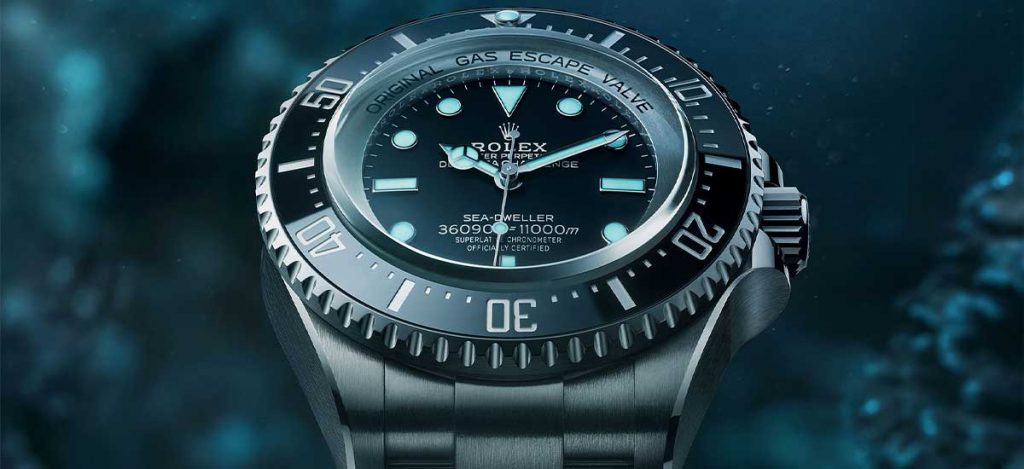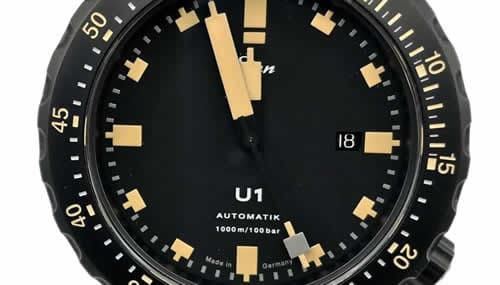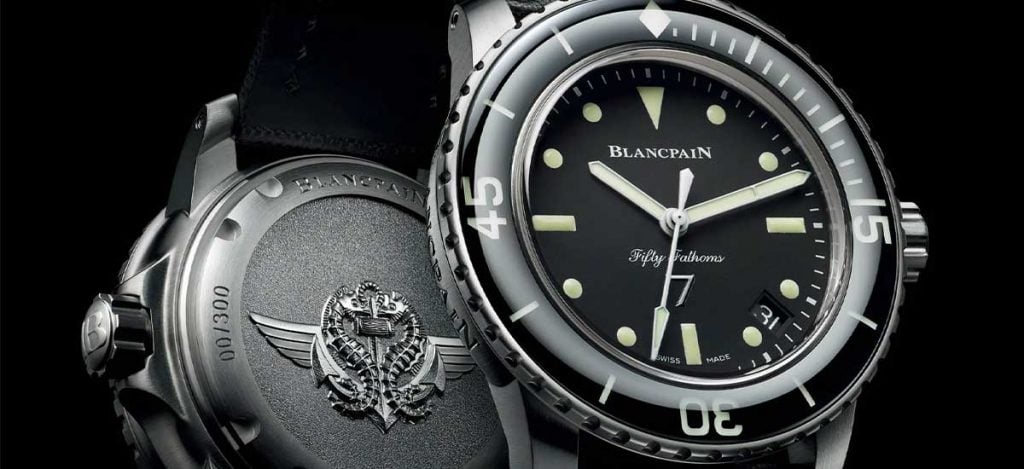
Nothing will shake up the watch industry like a new release from Rolex! Every Facebook Group, watch blog site, and YouTube personality erupts with positive and negative opinions immediately following any release, regardless of how subtle the changes are.
The release of the new Rolex Deepsea Challenge was different. Sure, everyone was quick to react with an opinion, but the changes they discussed were far from minute; some may even say they were huge! To better understand this new release from Rolex, let’s explore the path Rolex has taken to lead to their latest bragging right.
Rolex has always had an affinity for pushing the limits of what is possible with a mechanical wristwatch. From accompanying Sir Edmund Hilary on his Everest expedition to the deep explorations of the Undersea World of Jacques Cousteau. It is the later explorations that helped cement Rolex as the premier tool watch of choice for any type of modern explorer.
Through the expertise and technology derived from the commercially available Submariner line, Rolex pushed the limits once again while accompanying the Trieste on a record-breaking dive to nearly 11,000 meters in Mariana’s Trench back in 1960 with a specifically designed watch.
Fast forward to 2008, and Rolex was at it again. After nearly perfecting their Submariner and Sea Dweller lines, Rolex was after something that could once again push the limits. This resulted in the Rolex Deepsea, a commercially available dive watch capable of withstanding pressure at 3900 meters.
Four years later, in 2012, Rolex developed a special Rolex Deepsea Challenge to accompany James Cameron to another exploration of Mariana’s Trench. Although never commercially available, this watch is the inspiration for what was released in 2022.
The Rolex Deepsea Challenge, reference 126067, is the culmination of the last 70 years of Rolex innovation and their pursuit of dive watch perfection. Let’s look at 10 facts about this new watch and what its release means for Rolex and the rest of the watch industry as a whole.
1. The Rolex Deepsea Challenge is Large and in Charge!

Before diving into this new release, we need to address the elephant in the room. The 50mm elephant! The Rolex Deepsea Challenge is a very large watch. Coming in at 50mm wide and 23mm thick, this watch would have difficulty sliding under even the loosest cuffs.
The Deepsea Challenge dwarfs the standard Deepsea model at 44mm, a timepiece openly criticized for its large dimensions. Despite this large size, the watch remains “relatively” wearable considering what it is capable of. Afterall, the Deepsea challenge is not meant to melt away on your wrist when paired with a suit; it’s a tool engineered for a purpose.
2. New Materials! At Least New to Rolex
Rolex is not a brand known for pushing the boundaries of exotic materials. Sure, they like to experiment with little brother Tudor, but Rolex doesn’t usually get in on the fun. The Deepsea Challenge utilizes Rolex’s new RLX titanium. This metal is grade 5 titanium, a material known for its corrosion resistance and lightweight properties compared to stainless steel. Why is this a big deal? This is the first time Rolex has constructed a watch entirely out of titanium.
It has been used for the case back on previous models but never for an entire piece. With a watch sized at 50mm, titanium allows this piece to be somewhat wearable at “just” 251 grams, as opposed to the 350+ that it would be had it been fashioned out of stainless steel. The rest of the industry has been much quicker to adopt titanium. But, by Rolex acknowledging its functionality, there is no doubt that many other brands will be lining up to do the same.
3. This Watch Can Go Deep!
The Rolex Deepsea Challenge has a water resistance of 11,000 meters. If you find yourself casually strolling the deepest depths of the ocean, you will be as dead as a person can be, but at least your watch will still be ticking away. There have been a few watches accompanying dives to this depth, so what makes this watch special?
If you wanted one of those other watches, you needed to be a museum curator, an eccentric billionaire collector, or James Cameron (who honestly might be all 3). The Rolex Deepsea Challenge, however, is a commercially available watch, meaning that this technology is finally available for the everyday consumer.
Will we ever need a watch rated to go down to this depth? Absolutely not! Is it fun to know that your wristwatch could reach the deepest depths of our planet? Hell yeah!
4. Bells and Whistles!
How does Rolex manage to achieve these great depths? There are a few very clever enhancements from the standard Submariner line that help differentiate this model. The first is the helium escape valve. This technology is fairly common today, but when first introduced in the 1960s was instrumental in allowing watches to reach great depths.
The condensed version is that, at great depths, compressed helium particles, which are smaller than water, can enter the watch and create a pressure difference during the decompression process. This would cause the crystal of a timepiece to pop off, effectively ruining your watch and your day. The Helium Escape Valve allows these helium particles to freely enter and escape your piece without the possibility of water ingress.
The other enhancement to the Deepsea Challenge comes in the form of the Ring Lock System. This system is a nitrogen-alloyed stainless steel compression ring that helps to absorb the pressure experienced through the caseback and crystal of the watch. With this compression ring, the water-tight seals maintain their shape and ensure a proper fit.
These innovations may not seem as groundbreaking as they did in 1967 and 2008 upon their introduction. But, combined with other refinements, they allow this watch to go deeper than any commercially available watch.
5. It’s Not a Cheap Watch! But Would It Be a Rolex if It Was?
Rolex sports models are not necessarily known for their bargain prices. This Deepsea Challenge is certainly no different, coming in at about $26,000. That’s a lot of money for a tool watch, but to Rolex’s credit, this watch is doing something that no other commercially available watch can do.
Considering that a standard Rolex Submariner can set you back more than $15000 on the preowned market, if you can acquire this watch at retail, you would be getting an absolute bargain. The most surprising part of this equation is that, in a world of complete scarcity regarding new Rolex models’ availability at retail, people are having some success with this model.
Although anecdotal, my timeline has been full of people trying this watch on for fun but ultimately turning it down due to its size or higher retail price. Given the history of Rolex sports models, could we be sleeping on the next auction house sweetheart?
6. Consistency in Design
If there is one thing that differentiates Rolex from its competitors, it is its ability to stay consistent. This glacial pace of refinement leads to some people getting bored with the design of many Rolex models. This iconic look has allowed a Rolex watch to create a distinct identity. This new Deepsea Challenge model is very distinctly a Rolex dive watch.
There are changes to the size and the rehaut, but the timepiece is still a refinement of the original design. If you compare this watch to a vintage Rolex Submariner, although the Submariner will look downright diminutive, you will be able to see the design characteristics that have carried through several new iterations and models. Consistency has always been one of the keys to Rolex’s success.
7. Rolex vs. Omega
Rolex and Omega are no strangers to doling out right hooks to each other. As soon as one company reaches a milestone, the other is there to one-up them. There is no greater example of this back and forth than when it comes to deep sea exploration. With the release of the Rolex Deepsea in 2008, Rolex set the standard for a commercially available dive watch by achieving a water resistance of 4000 meters.
In early 2022, Omega put the watch industry on notice by releasing the Seamaster Planet Ocean Ultra Deep. This large titanium watch’s capability of reaching depths of 6000 meters not only gave them the title of deepest depth rating for a commercially available dive watch, but it did so in a convincing fashion, surpassing the Rolex by 150%.
Rolex was officially in second place, a position they did not take too fond of occupying. The “pressure” was on, and less than a year later, we received this new Deepsea Challenge. A watch that doubled the depth rating of the Ultra Deep and delivered what could only be described as the gut punch of a lifetime to Omega.
8. How Does This Watch Impact Tudor?
When it comes to the relationship between Rolex and Tudor, the lines have become very blurred over the last few years. Every time we think we have this relationship figured out, Tudor decides to introduce a solid gold watch, or Rolex refocuses on the tool watch market, completely confusing every watch enthusiast. The release of the Deepsea Challenge further complicates how we view these two intertwined brands.
For the last couple of years, the trajectory was heading toward a path of Rolex making high-end luxury watches, while Tudor filled in the hole in the market Rolex left behind for premium tool watches. Rolex focusing on new materials like titanium and creating a timepiece aiming to push the limits of a tool watch feels very “old Rolex” and something we thought Tudor would be concentrating on. Perhaps the relationship between these two brands isn’t as clear-cut as we all assumed.
9. What This Means for the Future of Rolex
The new Deepsea Challenge says more for the future of Rolex than almost any other modern release over the last few years. Rolex can now manufacture watches out of titanium. The possibilities there are endless. Can you imagine an RLX titanium Submariner? I am sure that would be an easy watch to get at retail!
Looking beyond just the possibilities with materials, Rolex can now do something they have rarely been able to do over the last several years. They’ve proven that they still have the ability to surprise us. Maybe their next release will push the limits again in terms of specification, or we may see another unique material, like a ceramic case. The only thing that’s certain is that we might have something a little more interesting than 1mm in case size to debate about next year.
10. A Call Back to the Past
The Deepsea Challenge represents a return to form for Rolex. Not just in their ability to surprise us or make a tool watch but their ability to push the limits of what is possible. For a company that earned its reputation through accompanying real-life explorers as they discovered the previously undiscovered, the modern luxury status of Rolex just never seemed to fit.
These watches have been on people’s wrists, pushing boundaries and setting records. They were meant to be a tool; and not just a tool to increase wealth by sitting in a bank safe and appreciating in value. I am sure this watch will one day be an investment, but it certainly wasn’t designed to be.
Let the call back of the beautifully chamfered lugs of the Deepsea Challenge transport you to a time when Rolex not only took the extra time for aesthetic detail but also prided themselves on creating watches that were meant to be used!
The Leviathan of the Past Rises Again
The Rolex Deepsea Challenge is, in many ways, a misunderstood release from Rolex. It has quite a few detractors who see this release as nothing more than an oversized Submariner. When you view this watch through a narrow lens of their luxury prestige, I can see how one could come to this opinion.
It’s important to remember that although Rolex has undoubtedly played into that luxury image with some of its pieces, they still produce fully capable tool watches. In many ways, the second-hand market has elevated these pieces to an ultra-luxury status. The Deepsea Challenge is an evolution of Rolex’s prestigious tool watch history, not their luxury one.
When you view this watch through that lens, although still being very large, the Deepsea Challenge is the modern definition of a tool watch.

















